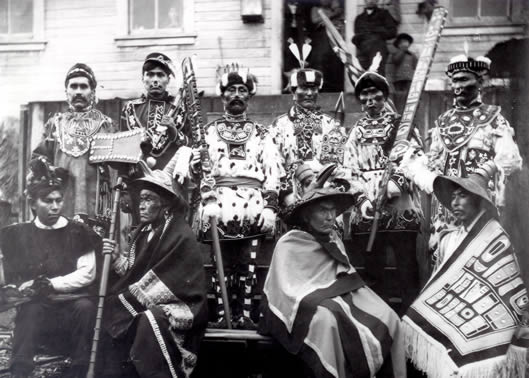
Raven Yakutat Tlingits at a Sitka Potlatch, Dec. 9th, 1904.
The word “potlatch” means “to give” from the Chinook jargin on the Columbian River. For many Northwest Coast Native peoples, includng the Tlingit people, potlatches (ku.éex’) were an immensely important occasion featuring speeches, dancing, singing, feasting, and the lavish distribution of property. They were given by high-ranking members of a village to celebrate publically an event of great importance such as a house dedication, the raising of a totem pole, honoring the deceased, or even to regain status following a dishonor or simply to raise the social rank of the host. A potlatch might last for weeks and be the pinnacle of a host’s life as well as leave him destitute–but if there followed a resultant raise in prestige for himself and his clan it was considered well worth the price and effort.
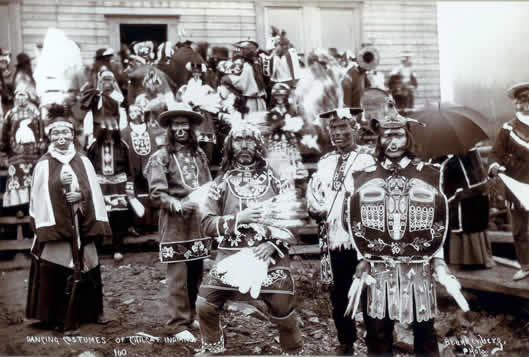
Chilkat Tlingits at a potlatch hosted in Klukwan in 1900.
In the case of honoring the dead, the potlatch was the culmination of a series of funeral rituals and ceremonies. Custom dictated a wake, a cremation, and post cremation feasts. All ceremonies, including the finale, the potlatch feast, served to strengthen the alliance between the clan of the deceased and the moiety opposites (i.e. the living spouse’s lineage). The opposites were in charge of several funerary rituals including preparation of the body and final cremation. If the deceased was a high ranking individual, it was customary for the moiety opposites to tear down and then rebuild his home for his descendants, or at a minimum, to refurbish the existing house. Ultimately the potlatch was given ostensibly to honor the deceased, but it also provided the opportunity to repay the moiety opposites for their part in the funeral service.
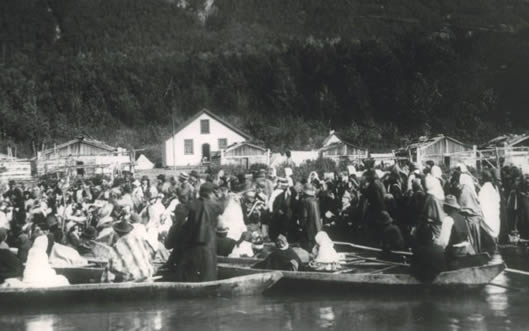
Tlingits landing for a potlatch in Klucktoo, a village located some two to three miles down river from Klukwan, circa 1895. Klucktoo was buried by a land slide sometime between this and 1900. The villagers were away at the time and there were no known casualties.
The guest list for a major potlatch would include the lineage and related lineage of the deceased, the widow’s lineage (assuming the male of the household died) and guest clans, usually from another village. Guests and hosts alike turned out in Tlingit regalia for what usually amounted to several days of celebration. Elegantly prepared food was served and entertainment included singing, dancing, and eating contests. One story goes that, upon rebuilding the famous Whale House in Klukwan, a potlatch was hosted with visiting clans from Wrangell and Sitka in attendance. An eating contest was held between equal numbers of men from each visiting clan. The Wrangell team ate from a hollowed out log, while the Sitka group tackled a huge spruce root basket called the “mother of baskets.” The Wrangell team was victorious, but only through trickery. During the excitement they concealed large scoops of food under nearby platforms.
A more serious episode is chronicled in which an eating contest participant was unintentionally killed when he was served cranberries, dried hemlock bark and oil. After downing it all, he asked for a drink of water which, unfortunately, caused the bark to swell and his stomach to burst. The host had to pay the victim’s clan several slaves in compensation.
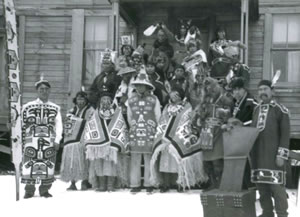
A potlatch celebrating the dedication of the George Kasko house in Klukwan, 1938.
Among certain groups, potlatches became very competative and property might be destroyed to demonstrate the host’s wealth. This fueled the disfavor of early missionaries and government agents who viewed the ceremony as barbaric and considered it“wasteful, unproductive and injurious to the practitioners.”European settlers could not reconcile the practice of giving away (muchless destroying) nearly all ones hard-earned possessions with the ideals of their capitalistic society. It has also been hypothesized that early settlers felt threatened by large gatherings of natives who might become unruly–pow wows among Plains Indians had been blamed for inciting various uprisings.
In 1884, Canada outlawed potlatches and the U.S. followed suite in the later part of the 19th century on the pretext of “leading [natives] towards a ‘healthier’ European mindset.” Although the law was poorly enforced (particularly in Alaska), the message was clear. It wasn’t until 1934 (1951 in Canada) that the U.S. repealed the ban. In the years since, the Tlingit people and many other native groups have seen a revitalization of their cultural practices, including the potlatch.
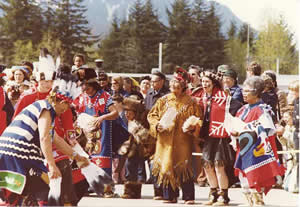
Dancers at the Friendship Pole raising in front of the Haines Elementary School, May 7, 1977.
Several early potlatch traditions have carried through to modern times. One year after the death of a Tlingit, family members may elect to host a potlatch in that person’s honor. Following a solemn beginning of memorial songs and speeches, the potlatch gets underway. As in the old days, favorite foods of the deceased are served, and also given as gifts for guests to take home. Other gifts include the customary giving of blankets (commercial, today), and money to those who helped with the services (still moiety opposites). A host may give gifts in moderation without losing face. Dancing and singing continue to be major potlatch activities and people frequently travel from neighboring towns for the ceremony.
Barbara Waterbury, 1987
updated and revised by Blythe Carter, 2013
Bibliography:
Billman, Esther. Tlingit Bulletin Number 1. Sitka, Sheldon Jackson Museum Press. 1975.
Jonaitis, Aldona. Art of the Northern Tlingit. Seattle, University of Washington Press. 1986
Kaiper, Dan & Nan. Tlingit: Their Art and Culture. Seattle, Hancock House Publishers. 1978.
Krause, Aurel. The Tlingit Indian. Gunther, Erna, Translator, 1956. Seattle, University of Washington Press. 1985.
Olson, R.L. Anthropological Records. Vol. 26. Social Structure and Social Life of the Tlingit in Alaska. Berkeley, University of California Press. 1967.
Mellott, Elsie. Gei Sun dancer, Haines, Alaska. Personal interview.
Wallace M. Olson, The Tlingit: An Intruduction to Their Culture and History, 1997.
